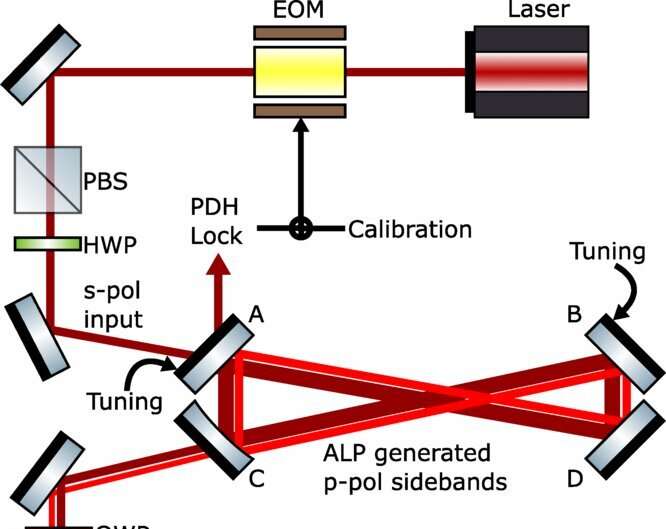Researchers at MIT recently published the first results of an experiment aimed at searching for axion dark matter by probing the axion-induced birefringence of electromagnetic waves. While these findings, published in Physical Review Letters, did not lead to the observation of signals associated with these hypothetical dark matter particles, they established a new technique to search for axions using a tunable optical cavity.
“The experiment was proposed in 2019 from a collaboration between our lab and our colleagues at the MIT Center for Theoretical Physics, when we were thinking about new ways to search for a hypothetical dark matter particle called the axion,” Evan Hall, research scientist at MIT’s LIGO lab, told Phys.org.
“Any observable interaction between axions and standard matter is expected to be very faint. We realized that the problem of trying to find a faint signal was a very similar problem to the detection of gravitational waves, which is another kind of very faint kind of signal detected only recently.”
After various theoretical discussions and considerations, Hall and his colleagues realized that the lasers and optical tools currently used by the LIGO experiment to detect gravitational waves could be repurposed to conduct axion searches. This gave rise to the Axion Dark-Matter Birefringent Cavity (ADBC) experiment, which first started collecting data in 2022.
“We wanted to demonstrate experimentally how to use these tools to pull off an axion search,” explained Hall. “Light comes in two polarizations—horizontal and vertical. Axions, if they exist, are expected to convert one polarization into the other. In our lab, we use a laser to generate vertically polarized light, and we look for any hint that axions have converted some of that light into the horizontal polarization.”
The detector that the ADBC experiment relies on is made up of 4 mirrors arranged to form an optical cavity (i.e., a structure that traps light). This optical cavity stores and recirculates light beams originating from a laser thousands of times, which would enhance faint axion signals.

In the first stages of the experiment, Hall and his colleagues used the detector to search for axions with masses around 50 neV (about 10–40 grams). Notably, another research team based in the United Kingdom has recently been searching for axions with masses around 2 neV using apparatus resembling the one employed at MIT.
“Our work showed that this new kind of cavity can be tuned to widen the range of possible axion masses that can be searched over,” said Swadha Pandey, fourth year Ph.D. student at MIT.
“Specifically, we showed that the cavity can be tuned by adjusting the angles of its four mirrors. Tunability is an important criterion for making the apparatus useful for dark matter searches. Since nobody knows what the axion mass might be, we need to search over a wide range of possible masses.”
The first results of the ADBC experiment place constraints on the coupling of axionlike particles and photons. While they have not detected axions so far, they could inspire additional research efforts aimed at detecting these hypothetical dark matter particles using optical cavities, potentially contributing to their experimental discovery.
“Having shown that this method can work over a broad range of axion masses, the next step would be to build a larger, more sensitive experiment,” added Pandey.
“Such an experiment would use more laser light, so that there are more photons interacting with the axions, and the experiment would be larger, to increase the time that the photons can interact with the axions. Automation of the tuning mechanism and clever designs for mirror coatings are also essential for scanning across the entire available range of axion masses.”
More information:
Swadha Pandey et al, First Results from the Axion Dark-Matter Birefringent Cavity (ADBC) Experiment, Physical Review Letters (2024). DOI: 10.1103/PhysRevLett.133.111003.
© 2024 Science X Network
Citation:
First results from the Axion Dark-Matter Birefringent Cavity experiment establish a new technique for axion search (2024, October 18)
retrieved 20 October 2024
from https://phys.org/news/2024-10-results-axion-dark-birefringent-cavity.html
This document is subject to copyright. Apart from any fair dealing for the purpose of private study or research, no
part may be reproduced without the written permission. The content is provided for information purposes only.

